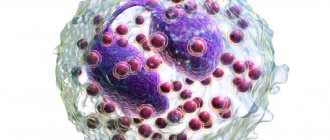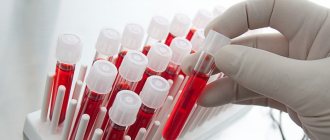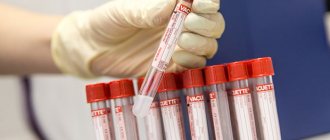General information
Those same peptide compounds that contain protein play a transport function in the circulatory system. That is, with their help, micronutrients enter the cells, and waste products are removed from them.
Protein is also an integral part of the formed elements, participating in the synthesis process:
- hemoglobin;
- red blood cells;
- leukocytes;
- platelets.
With the help of proteins, energy is also released from the burning of fats and carbohydrates, and accordingly, the nominal body temperature is maintained.
The main types of proteins in human blood plasma:
- Albumin is the main plasma protein and plays a key role in maintaining blood pressure and the osmotic movement of blood through the blood vessels. It is also a binder for complex lipid chains and many drugs.
- Globulins primarily take on the transport function. It is with their help that vitamins, minerals, and protein combinations (from which muscle tissue is subsequently formed) are distributed throughout the body. Globulins also take part in the functioning of the immune system, transporting leukocytes to sites of infection.
- Fibrinogen is a water-soluble protein that ranks third in terms of quantity in the blood. Upon contact with thrombin, it precipitates, forming so-called “fibron threads” - they form the basis of the fibrin polymer, which literally plugs damaged blood vessels in combination with platelets.
Above are only the main variations of proteins included in the blood. But in total there are over 100 varieties, each of which takes on a number of biochemical functions of the body.
Protein shake for breakfast
To prepare a protein shake, whey protein is used, which quickly eliminates the feeling of hunger and does not prevent obesity. Recipe for a tasty and healthy drink:
- Almond milk – 225 g.
- Protein powder – 1 scoop (28 g). It contains 20 g of protein.
- Any fresh berries - 1 cup.
- Stevia (or sweetener) to add sweetness.
- Crushed ice – 1/2 cup.
All components are combined and blended using a blender. You can increase the amount of protein in your smoothie by adding chia or flax seeds to it.
Normal level of total protein in blood
According to accepted standards and directives of the WHO (World Health Organization), the following indicators (grams per liter) are considered the norm for total protein in the blood:
- newborns – from 45 to 70;
- children under 3 years old – from 51 to 73;
- children under 15 years old - from 60 to 81;
- from 15 years and older – from 65 to 85;
- over 65 years old - from 62 to 81.
Indicators are conditional. Much more important for diagnosis are the indicators of individual proteins, as well as their derivative elements.
Normal values during pregnancy
Low total protein in the blood during pregnancy can provoke the development of many pathologies in the unborn child and therefore requires medication to increase it. It is protein that acts as a “building component”; organs, tissues, neurons, blood, and so on are formed from it.
Accordingly, its deficiency will lead to the fact that the fetus will not be able to fully form. This is especially important in the second and third trimester, when the child’s body is actively gaining weight.
Blood protein levels decrease significantly during pregnancy. This is a normal phenomenon, and indicates that a significant part of it is transported through the placenta to the body of the unborn child.
If for an adult the norm is about 65–85 grams of protein per liter of blood, then during pregnancy this figure drops to 55–65 grams per liter . Accordingly, a decrease in blood protein levels below 55 is considered a deviation from the norm.
Greek yogurt is the highest protein yogurt
Greek yogurt is high in protein. It is enough to consume 240 g of this product for the body to receive 20 g of protein. These figures are 2 times higher than in classic yogurt.
In several studies, scientists have found that eating Greek yogurt promotes the production of intestinal hormones GLP-1 and PYY, which dull the feeling of hunger and promote rapid satiety [4].
This tasty product is also useful because it contains conjugated linoleic acid, which promotes weight loss. This has been proven experimentally [5], [6].
You can add fresh berries and fruits to Greek yogurt; sauces and dressings can be made from it to improve the taste of most dishes.
How to increase - 3 main methods
Below we will look at the 3 main ways to influence the level of total protein in the blood plasma.
Change your diet
What foods increase protein levels in the blood? The answer is obvious - those with a high protein content. These include:
- Meat. Beef, on average, contains up to 30 grams of protein per 100 grams of product. In chicken fillet - up to 25 grams and so on.
- Egg whites. One boiled egg contains about 3 grams of protein.
- Cottage cheese. Contains up to 18 grams of protein per 100 grams of product. Low-fat - a little less, about 12 - 14 grams.
- Seafood. Fish contains approximately 12–15 grams of protein per 100 grams. More in caviar.
- Legumes. This also includes peas and beans. Contains 20 to 25 grams of protein per 100 grams.
- Cereals. Depending on the culture, they contain from 8 to 12 grams of protein per 100 grams of the finished product.
- Nuts. Contains up to 30 grams of protein. This also includes peanuts, pistachios, walnuts, and pine nuts.
But it is worth considering that protein is normally absorbed only with sufficient levels of vitamins, minerals, and other micronutrients in the blood. The carbohydrate indicator is also important, since energy is necessary for the normal course of the digestion process. Accordingly, in order to increase the amount of protein that the body absorbs from food, it is necessary to follow a varied and nutritious diet.
The protein requirement in men is slightly higher. This is due to a more developed muscular system, the basis of which is protein compounds. But the level of protein in the blood of men and women is almost the same.
Use proven folk remedies
To increase blood protein using folk remedies, the following options are often recommended:
- Decoction of corn grains. To prepare, take 5 tablespoons of dry ground seeds and add 2 liters of water. Bring to a boil, then let simmer for another 20 minutes over low heat. Afterwards, leave until the grains become soft. Next, strain, take 100 grams of broth 2 times a day after meals. The course of treatment is until the prepared decoction runs out.
- Seaweed. Consumed in the form of a salad with the addition of vinegar, spices, onions, garlic (cook to taste, there is no clear recipe). Eat 2 times a day for lunch and dinner. It is recommended to eat at least 40 grams of algae at one time.
Take vitamin complexes
There are no universal drugs that can quickly raise protein in the blood. Only a diet combined with vitamin supplements can contribute to this. The best performers in this regard were:
- Alphabet. Combined vitamin complex. Perfect for both men and adults, as well as children over 12 years old. It contains iron, which stimulates biochemical processes involving proteins.
- Hematogen. Sold in pharmacies in the form of diet bars. It also contains a lot of iron.
- Duovit Multivitamin. Suitable also for children.
Again, these medications should only be taken in combination with a protein diet. Otherwise, there will be no improvement.
Combine Peanut Butter with Fruit
Fruits are sources of vitamins, fiber and antioxidants, but they are low in protein. You can increase its content during meals by combining them with peanut butter. 2 tbsp is enough. l., so that the body receives not only the benefits of fruit, but also 8 g of protein.
Scientists have proven that eating peanut butter helps control hunger, lower blood sugar and improve overall health [9], [10].
What reduces it?
Blood protein levels rapidly decrease when exposed to the following factors:
- Vegetarianism. Involves avoiding food of animal origin. But it is meat, milk, and eggs that contain the most protein, while plant foods contain several times less.
- Lactation. During breastfeeding, protein naturally decreases. This is not a deviation from the norm. But if it falls below 55 grams per liter of blood, then the diet should be adjusted.
- Lack of fluid in the body. It may occur while taking certain medications, alcohol, or during significant physical exertion.
- Liver diseases. Most of the proteins that then enter the blood are produced in the liver. Accordingly, diseases of this organ can negatively affect the synthesis of proteins that form the basis of blood plasma.
- Exhaustion of the body. Most often occurs during long-term treatment of infectious diseases. At the same time, not only the level of protein in the blood drops, but also the rate of its absorption decreases.
- Some diseases of the endocrine system. In particular, diabetes mellitus.
- Kidney failure. Often leads to an increase in protein in the urine.
- Diseases of the gastrointestinal tract. They slow down the process of breakdown of protein compounds, and accordingly, the body experiences a deficiency of amino acids.
Eggs for breakfast
Oatmeal contains more protein compared to all other cereals. One classic serving contains about 6 g of protein. However, if you compare oatmeal with eggs, it loses significantly. Thus, three chicken eggs contain 19 g of protein, as well as selenium and choline necessary for the body.
A number of studies have shown that eating eggs can reduce appetite and keep you feeling full longer. Therefore, a person does not overeat during dinner.
Eggs for breakfast are not only a way to fill your body with protein, but also a “cure” for fighting bad LDL cholesterol. Therefore, their consumption in food is a prevention of cardiovascular diseases [2], [3].
Read more: TOP protein-rich foods
Canned fish
Canned fish is a source of proteins. It is convenient to use as a snack between main meals. The choice should be made in favor of canned mackerel, salmon, herring or sardines. These types of fish saturate the body not only with protein, but also with omega-3 fatty acids. 100 g of product contains 20-25 g of protein and no more than 200 kcal. It is good to combine canned fish with fresh vegetables.
Author of the article:
Mochalov Pavel Alexandrovich |
Doctor of Medical Sciences therapist Education: Moscow Medical Institute named after. I. M. Sechenov, specialty - “General Medicine” in 1991, in 1993 “Occupational diseases”, in 1996 “Therapy”. Our authors
Soya beans
Soybeans are popular among vegetarians as they are the leaders in protein content among other legumes. One serving contains about 17 g of protein and no more than 180 kcal.
Soybeans are an excellent dish for saturating the body with antioxidants, the main one of which is kaempferol. In studies with rodents, it was found to promote weight loss and reduce blood sugar levels.
Soybeans can be added to meats and stewed vegetables to make the dish even healthier.
Read more: 10 products that replace meat
Cottage cheese - a product for breakfast, lunch and dinner
Cottage cheese is a source of protein. One 225g serving provides 25g of protein. Scientists conducted an interesting study. It involved women who followed a diet with a high and normal content of dairy products. As a result, waist sizes decreased significantly in those subjects who ate more cottage cheese [11].
Fresh natural cottage cheese is delicious in its pure form. It can be supplemented with nuts, berries, seeds, stevia, cinnamon and other products to diversify your diet.











